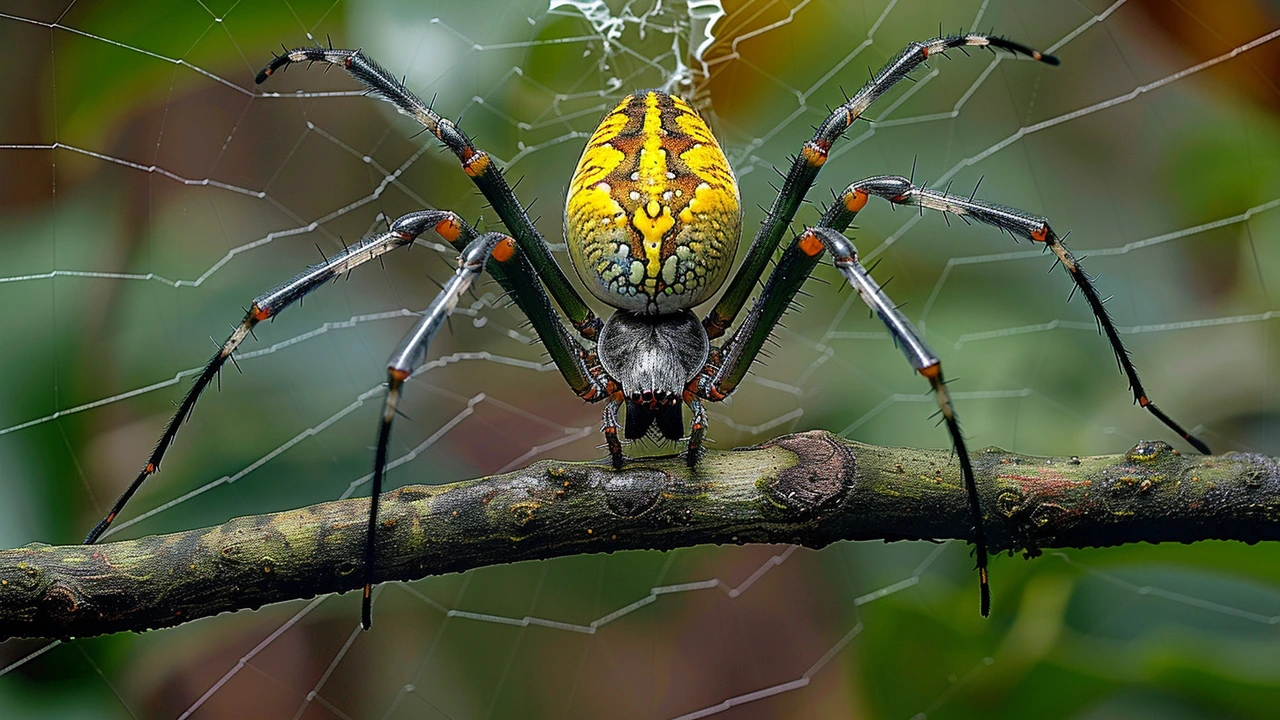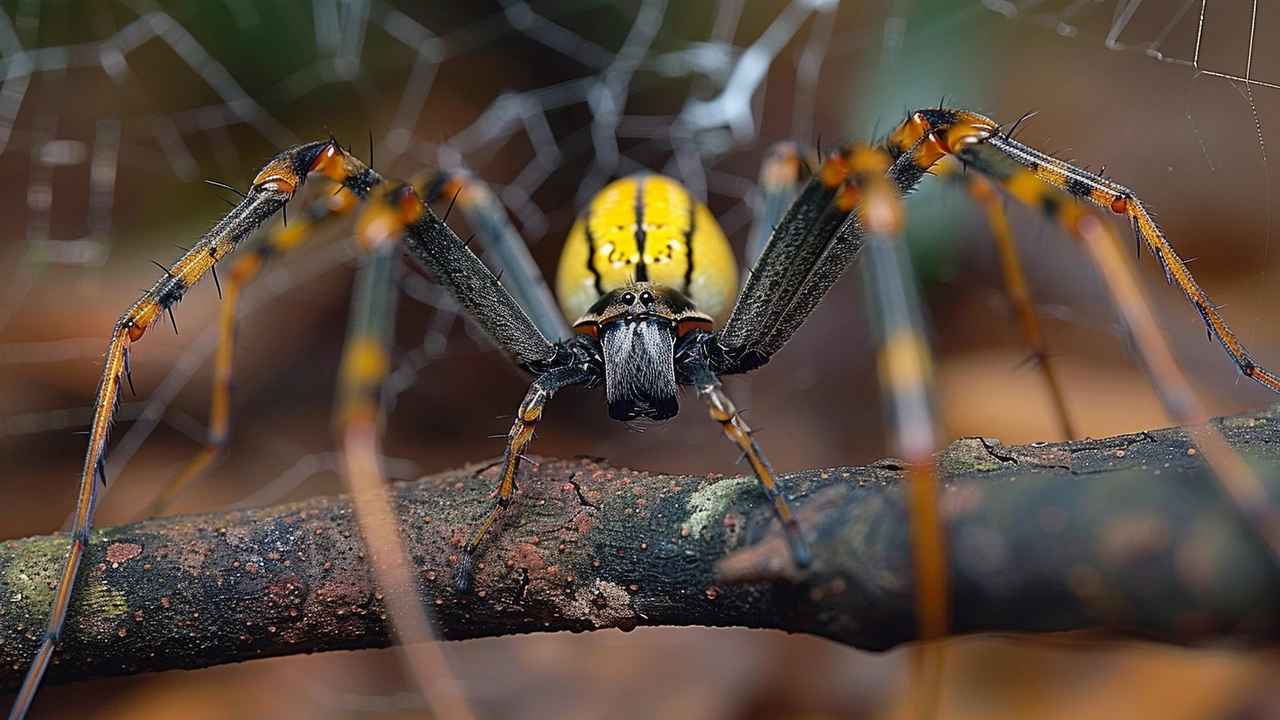As New Jersey residents grapple with the arrival of Joro spiders, a closer look reveals that these brightly colored arachnids are largely harmless compared to other local critters. The Joro spider, native to East Asia, boasts a striking leg span of up to four inches and constructs intricate webs that can span up to 12 feet. However, despite their fearsome appearance, their venom poses no threat to humans or pets. Their mandibles are simply not strong enough to puncture human skin. This revelation might be a relief for many, but the state is home to other, more insidious threats that necessitate vigilance.
Ticks stand out as one of the most significant dangers in New Jersey. These tiny arachnids, particularly black-legged ticks, are notorious for spreading Lyme disease, an illness that can lead to severe health complications if left untreated. Other diseases transmitted by ticks include anaplasmosis, babesiosis, ehrlichiosis, Rocky Mountain spotted fever, and the lesser-known but no less worrying Powassan virus. These ailments are not only debilitating for humans but can also affect pets such as dogs, making it essential for residents to take preventive measures against tick bites.
Tick Prevention Tips
To avoid tick bites, it's crucial to stay on well-traveled paths and avoid walking through tall grasses and bushy areas where ticks thrive. Wearing long sleeves and pants, and treating clothing and gear with products containing 0.5% permethrin, can offer additional protection. Using a fine-tipped tweezer to remove ticks promptly and thoroughly checking for ticks after spending time outdoors are simple yet effective strategies to minimize the risk. Even with these precautions, the prevalence of ticks in New Jersey requires constant awareness.
New Jersey's Venomous Snakes
In addition to ticks, New Jersey is home to the northern copperhead and the timber rattlesnake, both of which are venomous. While these snakes typically avoid human contact, they can become aggressive if they feel threatened. The northern copperhead, with its distinctive hourglass-patterned body, uses camouflage to blend into its surroundings, making sudden encounters more likely. Timber rattlesnakes are more inclined to warn intruders with their distinctive rattle, giving people a chance to back away. Although bites from these snakes are rarely fatal thanks to prompt medical treatment, they can cause significant pain and require immediate attention.
Recognizing and Avoiding Snakes
Recognizing these snakes and their habitats is key to avoiding unwanted encounters. Northern copperheads are typically found in forested, rocky, and wetland areas, whereas timber rattlesnakes prefer wooded regions and rugged terrain. Wearing sturdy boots and keeping to clear paths can reduce the risk of snake bites. Teaching children about the importance of not disturbing snakes they encounter can also help prevent dangerous situations.

Black Widow Spiders: A Rare but Potent Threat
Another spider in New Jersey that deserves caution is the black widow spider. Known for their distinctive black bodies with a red hourglass marking on their abdomens, black widows present a more significant risk to humans than Joro spiders. Their venom, while not typically fatal, can cause severe pain and muscle cramps. However, bites are rare and often occur when the spider is inadvertently provoked. Black widows tend to avoid human contact, preferring dark, undisturbed areas such as garages, basements, and woodpiles.
The Ecological Menace of the Spotted Lanternfly
A less direct but equally serious threat is posed by the spotted lanternfly, an invasive species that has significant implications for New Jersey's agriculture and ecosystems. Native to China, these insects have spread across several states, wreaking havoc on a wide range of plants, from grapevines and fruit trees to hardwoods. The spotted lanternfly’s feeding activity weakens plants, making them more susceptible to disease and extreme weather, and their presence increases agricultural costs as farmers spend more on pest control measures.
Managing the spread of the spotted lanternfly requires coordinated efforts from residents and authorities alike. Simple actions, such as inspecting and destroying egg masses found on outdoor surfaces, reporting sightings to local agricultural departments, and adhering to quarantines in affected areas, can help control their proliferation. Public awareness and community involvement are crucial in slowing the spread of this destructive pest.

Understanding Relative Risks
While much attention has been given to the emergence of Joro spiders in New Jersey, it is vital for residents to recognize that these spiders pose no real threat. Instead, attention should be directed towards more serious and established threats like ticks, venomous snakes, and black widow spiders, alongside the growing issue of the spotted lanternfly. Informed residents, armed with knowledge and preventive measures, can better safeguard themselves and their families against these varied dangers.
New Jersey is a state rich in biodiversity, and with that comes the responsibility of coexisting with both harmless and potentially dangerous wildlife. By staying informed and practicing simple safety measures, New Jerseyans can enjoy the great outdoors while minimizing the risks associated with the state's diverse fauna.

Emanuel Hantig
June 6, 2024 AT 20:33Wow, reading about the Joro spider really puts things into perspective 😊. It's easy to let fear of the unknown take over, but when you step back and think about the bigger picture, you realize most of these critters are just trying to survive. The real threats here are ticks and those sneaky lanternflies, so focusing on proper prevention makes more sense. Keep your eyes on the trails, wear long sleeves, and trust that the Joro won't bite you. Stay safe and enjoy the outdoors!
Byron Marcos Gonzalez
June 10, 2024 AT 08:13Behold the tale of a flamboyant spider that looks like a tiny superhero-yet it's as harmless as a dandelion fluff! 🕷️
Chris Snyder
June 13, 2024 AT 19:33Good rundown on the actual hazards we face in the Garden State. Ticks are definitely the petty nuisances that can cause serious illness, and the black widow still deserves a respectful distance. For the Joro, just give it the space it wants and you’ll be fine. If you’re into pest control, treat your gear with permethrin as the article suggests. Happy hiking!
Hugh Fitzpatrick
June 17, 2024 AT 06:53Oh sure, because everyone totally loves spending their weekends dragging ticks off their legs like a weird hobby. 🙄 But seriously, a little vigilance goes a long way-just don't turn your hike into an outdoor surgery.
george hernandez
June 20, 2024 AT 18:13The Joro spider, with its vibrant orange‑black legs, has captured the imagination of many New Jersey residents who see it as an exotic invader. Its appearance can be startling to those unfamiliar with Asian fauna, and the initial shock often leads to rumors of danger. However, the reality is far more mundane; the spider’s venom is designed for small insects and cannot penetrate human skin. It builds elegant webs that stretch across shrubs and fences, providing a natural form of pest control by trapping flies and mosquitoes. While the webs may look imposing, they dissolve with the slightest breeze and pose no entanglement risk to humans. The creature’s mandibles are tiny, barely able to grasp the legs of a fruit fly, let alone a human finger. In many ways the Joro is a reminder that not every stranger is a threat, and that biodiversity can flourish alongside us. The bigger concern in the region remains the black‑legged tick, which transmits Lyme disease and other serious pathogens. Proper clothing, regular tick checks, and the use of permethrin on gear are proven strategies to mitigate that risk. Additionally, the spotted lanternfly continues its march across vineyards and farms, threatening crops and local economies. Community reporting and removal of egg masses help contain its spread. Venomous snakes such as the copperhead and timber rattlesnake also merit caution, but they tend to avoid human contact. Black widows, while potent, bite only when provoked and are seldom encountered indoors. By focusing on education and preventive measures, residents can coexist peacefully with the Joro spider without fear. So the next time you spot that colorful arachnid, take a moment to appreciate its role in the ecosystem and then move on with confidence. Ultimately, knowledge turns fear into curiosity and empowers us to enjoy the great outdoors responsibly.
bob wang
June 24, 2024 AT 05:33Indeed, the comprehensive approach outlined in the article is commendable; however, one must also consider the ecological ramifications of indiscriminate pest eradication, which, while seemingly pragmatic, could inadvertently disrupt local food webs, particularly those involving predatory insects that naturally regulate Joro populations, thereby necessitating a balanced, integrated pest management strategy, as opposed to a singular focus on chemical controls, 😊.
Seyi Aina
June 27, 2024 AT 16:53Yo, Joro spiders are just flashy lawn ornaments, not a crisis.
Alyson Gray
July 1, 2024 AT 04:13i get it man the Joro looks like a circus act but honestly it’s just another critter trying to survive in our backyard vibes! i’m not tryna scare anyone but i also ain’t tryna pretend it’s a monster
just keep an eye out and chill.
Shaun Collins
July 4, 2024 AT 15:33Seriously this whole Joro hype is just another news cycle drama.
Chris Ward
July 8, 2024 AT 02:53yeah i hear ya, but i think it’s cool to learn about new species anyway, they add a bit of excitement to the hike.
Heather Stoelting
July 11, 2024 AT 14:13Let’s keep moving forward and stay aware of ticks and spiders together we can enjoy nature without fear
Travis Cossairt
July 15, 2024 AT 01:33totally agree just remember to check your pets too they can bring ticks home
Amanda Friar
July 18, 2024 AT 12:53Oh great, another “look out for the spider” warning-because we all needed that extra dose of anxiety while we’re already battling ticks and lanternflies, right?
Sivaprasad Rajana
July 22, 2024 AT 00:13yeah, the real focus should stay on the tick prevention steps you already listed, like proper clothing and checking after hikes.
Andrew Wilchak
July 25, 2024 AT 11:33okay so i’m just gonna jump in here and say stop freaking out over every little bug it’s just nature doing its thing, if you don’t want a Joro on your porch put a screen on your door and move on.
Roland Baber
July 28, 2024 AT 22:53while it’s true that many of us feel uneasy about unfamiliar creatures, taking a moment to reflect on our place within the larger ecosystem can transform fear into appreciation, and a simple screen or a quick glance at a guidebook can bridge the gap between curiosity and comfort.
Phil Wilson
August 1, 2024 AT 10:13From an entomological perspective, the Joro spider (Trichonephila clavata) exhibits a phenotypic display that may trigger anthropocentric risk assessment biases, yet its ecological niche primarily involves predation on dipterans, thereby contributing to local arthropod population dynamics without imposing significant medical concerns.
Roy Shackelford
August 4, 2024 AT 21:33some people think the government is using these exotic spiders to distract us from the real agenda of monitoring our outdoor activities, but i guess we’ll never know.
Karthik Nadig
September 25, 2024 AT 20:33listen folks the only thing we should be worried about is protecting our own backyard from any foreign invader, spiders included 🌐🚫.